adidas is gradually moving a lot of its legacy models on to the Boost gravy train, and this year the Response Cushion hops aboard too. Okay, it isn’t called the Response Cushion anymore, but it is unofficially the Response Cushion 23, a Boost infused follow-up to last year’s Formotion and adiprene equipped version. With that, the shoe has been fundamentally transformed – both in the way how it looks and feels, and also in good and not-so-ideal ways.
Before we dive deep into the changes and what we think of them, it’s important to lay down a couple of things you should know about the Response Boost upfront. One, the shoe comes across as extremely well cushioned, even more so than the $30 more expensive Glide Boost. Two, the shoe fit runs half a size smaller than other adidas models, and one full size up if you’re coming from a Brooks, Nike or Saucony. Now with that context set, let’s proceed into the review break-outs, including reasons for the above mentioned (two) factors to come into existence.

$100 is the price of entry into the Boost line-up. Is it differentiated enough from other (and more expensive) Boost variants?
In our Supernova Glide Boost review, we commented that it was important for adidas to maintain a segmentation strategy. Because as more of their shoes start featuring the responsive Boost foam, it becomes increasingly harder to make sure that all those models are differentiated well enough. From the initial couple of models, the Boost line-up has expanded quickly to a wide assortment of price-points. With price tiering coming into the picture, adidas needs to maintain a healthy separation in features across the value ladder. A separation which the average runner or consumer can understand; things like why a particular shoe costs $30 less or more than the other.
Response Boost being the cheapest of the lot at $100, should ideally be less cushioned than the Supernova Glide Boost, but it isn’t. We tested the Response Boost against the Energy Boost, Glide Boost and Sonic Boost, and as far as cushioning feel was concerned, the Response Boost topped the Glide and Sonic. To trump over the Sonic was expected, but more than the Glide? adidas has tried to differentiate the Response from its $30 more expensive brother by glueing a cheap looking upper atop the Boost midsole, but what looks inexpensive does not necessarily translate into a cheap fit. After all, in running shoes, beauty is only mesh deep.
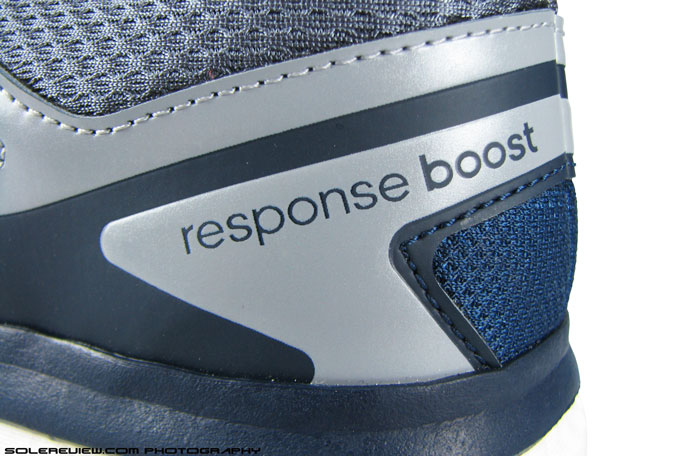
The upper execution looks like from a shoe few segments lower. The heel has ordinary screen printing, the patterns look bulky, and no longer features the welded TPU overlay of Response Cushion 22.

Four eyelet row (leaving out the last one) lacing. Three stripes logo is welded on lateral side and embossed on medial face.
Did we say cheap? Yes, materials used on the Response upper look like an unceremonious graft from a $30 shoe, evidently paying the price for the Boost premium. The synthetic leather used looks cut price and screen printing of the ‘Response Boost’ text in the heel and ’tech fit’ on the toe box looks tackily executed. The latter print isn’t even aligned across the left and right shoes, its position shifting slightly (see image above). If you were expecting the upper to top Response Cushion 22 standards, you will be disappointed. There aren’t any TPU welds over the heel anymore; all you get there are two ends of synthetic leather joining together in a seamed line. The lateral midfoot of Response Boost gets welded three stripes, but the cosmetic result ends up looking like embossing, which incidentally happens to be the case for inner midfoot.

Response Boost attempts to mirror the Energy Boost 2 Techfit. The stretch mesh is near-identical in fit and feel, the printed lines are shiny and thicker than EB-2
The forefoot bases its design and fit on the $160 Energy Boost 2 Techfit, using similar stretch mesh and printed overlays. The fabric is very close in fit and feel to the one used on the Energy Boost, and for all we know, it could be identical. The key difference is in the way how the lines are printed on the forefoot. Lines painted on the mesh are shinier and thicker (compared to matte and thin finish of EB 2), which places it few rungs lower in the aesthetic scheme of things.

The Response Boost has conforming synthetic leather midfoot panels, which does not make forefoot sides as tight as the Energy Boost 2 techfit.
The cosmetic lacunae have no bearing on the upper fit, because the latter is influenced purely by kind of last used, upper pattern engineering and midsole dimensions. While sharing the Energy Boost’s forefoot design, the fit differs in couple of ways. Firstly, forefoot fit on the sides is a little more relaxed than EB, inspite of the similar mesh used. That is because the Response Boost uses synthetic leather mid-foot panels instead of the hard plastic cage seen on the EB. The pointy ended plastic cage on the Energy Boost angled sharply down on the forefoot, causing that area to feel very snug. The Response Boost’s softer panels have more leeway in movement, easing off on the pressure.
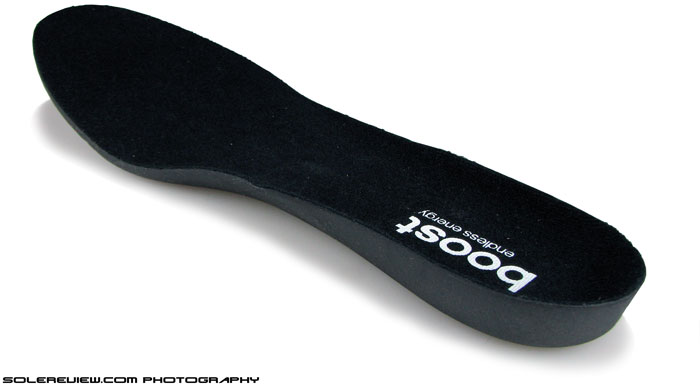
A 6mm thick molded EVA footbed sits inside the Response Boost upper. It also plays a part in how the upper fits.
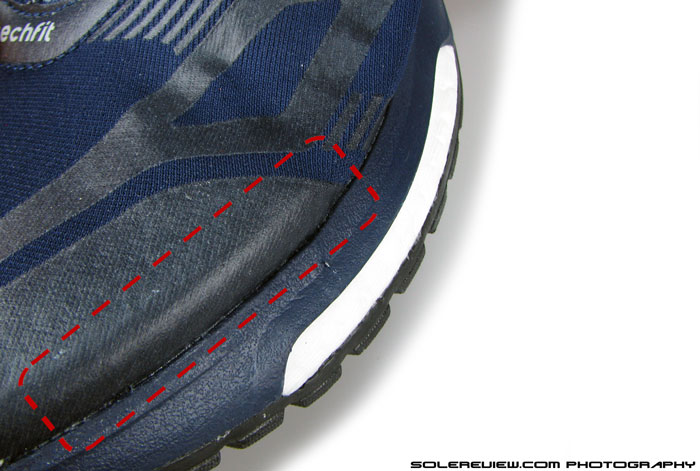
The footbed edges pushes out against upper mesh. Notice how it sits higher and wider relative to midsole base. That reduces the forefoot ceiling, making the fit narrow.
Secondly, the tip of Response Boost upper is extremely snug, causing the need for half-upsizing. A couple of things are at play here, neither of them desirable in a running shoe. One unique design trait of both the Energy Boost and Response Boost is that the removable footbed sits much higher in the forefoot compared to most running shoes. See the picture above, where we’ve highlighted the footbed silhouette stretched against the mesh. In most shoes, the footbed sits flush with the midsole edge and not above it. And that includes other Adidas shoes like the Supernova Glide Boost and the Sonic Boost.
For reasons only known to someone in adidas’ design department, the Energy and Response Boost depart from this norm. This higher than usual placement of the sockliner eats into precious forefoot space, making the fit very shallow, and hence snug. Not only that, forefoot base of the insole is wider than the midsole base it’s placed on – this oddity applies to both the EB-2 and RB.
But the Response Boost has a toe bumper which has a much lower profile than the standard. In fact, it is so slim in the front that it forces the lip of the outsole to curve inwards (we illustrate that in the accompanying image). That is a big deal, we don’t remember wearing a shoe (except the EB) which does that. Typically, the lip of rubber outsole stays parallel to front of your toes, and never curves inside. None of the other Boost shoes do that, so it looks like the Response Boost upper toe box was designed while playing a game of Candy Crush, and not under the usual attentive detail Germans are known for. The price of this oversight is having to go half size up even over existing adidas sizing. If you choose to wear regular adidas sizing in the Response Boost, you’ll have to live with the sight and sensation of your big toe poking awkwardly through the mesh.
This also makes wearing the Response Boost Techfit barefoot a non-possibility. If you do that, you’ll feel the toe box catch on your feet – the area where the Techfit printing goes over your big toe. There’s an internal stiffener there, and it digs into your toe. Some poor engineering right there.

Tongue is quilt stitched, but isn’t very padded. Not attached to the upper, but does not slide as much – owing to its short length.
Midfoot is snug but a few things could be better. The lacing features two lesser eyelet rows than the Sonic Boost, one less than the Glide Boost and on par with the Energy Boost. Less rows of eyelets means greater localized top down pressure on the tongue, so you need to work out the right amount of lacing tightness before your runs. Too tight, and there’s this feeling of dull pain over the instep. The tongue is stitch padded in the manner of Glide Boost, but like the Supernova, it lacks plushness. It isn’t gusseted, and doesn’t have a lace loop in the center, which used to be on the Response Cushion 22 – and integrated with reflectivity. So it was mildly surprising to see the Response Boost only experience little tongue slide. Much of that can be attributed to a shorter tongue than usual, which does make it slide resistant. The closed mesh and overlays makes the Response a warm shoe to run in.

Lower number of eyelet rows means more gap between them. Ends of the midfoot panel stand up, not sitting flush over the tongue.
A visual shortcoming of the four row lacing (discounting the fringe eyelet) is that the midfoot panels do not sit flush over the tongue. They tend to poke out between the lacing, much like the recently reviewed Nike Zoom Fly. This does not affect the shoe’s functionality, but loses a brownie point when it comes to the overall look.
Collar is soft and comfortable, using the same mesh seen on the Response Cushion 22 and Glide Boost. Much foam padding resides inside the collared walls, and the Achilles tab is soft too. This is one area of the shoe upper which has no faults to pick.
If the upper was found wanting in a few areas, the cushioned ride of Response Boost more than makes up for it. The midsole is a combination of regular EVA, which forms a rim around the top and also separates the forefoot and heel Boost foam by way of a midfoot bridge. Volume by volume, the Boost is used liberally, contributing to around 50% of the midsole material. And it is extremely well cushioned, yet responsive. At the start, we said that it rides softer than the Glide Boost, and that it is true. The Glide Boost has a thicker Boost layer than Response, but the cheaper shoe comes out on top due to two reasons. We’ll also talk about a possible third reason, but is purely speculative.

Boost foam window in heel reduces layering between foot and Boost. As an outcome, the Response Boost feels more cushioned than the $30 more expensive Glide Boost.
In the heel, the Glide Boost had a harder layer of EVA midsole foam separating the foot and Boost foam. The Response Boost doesn’t care about such subtleties, and straightaway cuts a window under the heel and forefoot insole, much like the Energy Boost. This brings the cushioning level closer to the foot, an element missing in the Glide. The outsole material also adds to the increased cushioning feel, as the rubber is incredibly soft. It is not blown rubber, but non-Adiwear rubber which is a new level of soft. Needless to say, the softness just compliments the compressive, yet responsive behavior of the Boost foam. Thirdly, we detected a change in the Boost foam’s structure compared to the type seen in Energy and Glide Boost. The Response Boost foam’s cluster appeared to be made of smaller globules, with a possible change in density. Could be a figment of our imagination, but after some crude testing using the index and thumb fingers, the Response Boost felt softer when pressed.
Transition is good, because most of the midsole is Boost foam. Heel landings come padded yet stable, and the forefoot behaves similarly – making the shoe suitable for both heel and forefoot strikers. The soft rubber has exceptional grip, and that also comes with an unwanted trade-off. The rubber durability is alarmingly poor, with primary contact areas witnessing a high level of wear early on. The soft rubber is no Adiprene, so the Response Boost is not the shoe for piling on mega-miles.
With a plethora of Boost flaunting models finding its way on to the shelves, virtual and otherwise, there is bound to be some confusion. We’ll round up the popular Boost models we’ve reviewed so far here, and compare the Response Boost with a short summary. We’ll thrown in the Adistar Boost and Supernova Sequence Boost in this later after we’ve finished reviewing them:
Response Boost vs. Energy Boost 2 techfit: Energy Boost has more cushioning and a tighter forefoot side fit. However, the tip of toe box is regular, which means you don’t need to go half-up from your existing adidas size. Outsole lasts longer. $60 more expensive.
Response Boost vs. Supernova Glide Boost: $20 extra is what you pay for the Glide 6. You get a more relaxed upper fit, better lacing pressure, ventilation and increased outsole durability.
Response Boost vs. Sonic Boost: Much firmer ride on the Sonic, with increased outsole durability and better upper fit. Similar price (not available in the US). Its 2014 replacement seems to be the Revenergy Boost, also an international, non-US model.
Response Boost vs. Adios 2 Boost: Upper fit is much snugger, shoe is lighter and highly breathable, and ride is minimal, optimized for faster runs. $40 more expensive than RB.
One area where the Response Boost pips all Boost variants mentioned here is forefoot flexibility. The soft rubber and mostly Boost midsole makes the Response forefoot easier to bend than the rest.
Someone posted a comment asking how the Pegasus 31 fared against the Response, so here are our thoughts. The Pegasus feels softer than adidas but not as responsive; we rate the Response cushioning feel as higher. But Pegasus decimates the Response on quality of upper materials and fit, and also on outsole durability.
Looking at the bigger picture, it is a paradox that the Response Boost feels more cushioned than the Supernova Glide Boost. It should be the other way around, and this behavior is symptomatic of the segmentation challenge we talked about. We also think a lot of recent adidas models are paying a high price in other areas once Boost comes in.
Let’s take the Response Boost, for example. The midsole is Boost infused, feels amazingly cushioned and all that, but look at the flip side of the situation. The upper is eroded of its earlier premium feel, the formation crash pad also disappears, a feature only restricted to only the $170 Adistar within the Boost offering. The fit has some sorting out to do too.
The Response Boost gives us the impression that adidas is treating the Boost platform as a meal-replacement equivalent. If that is indeed their thinking, then it sets course for a potentially dangerous precedent. The Boost is a powerful supplement at best, and not a substitute for three meals a day.
(Disclaimer: Solereview paid full US retail price for the shoe reviewed)
Note on ratings: Our numeric scoring of 8.3/10 is based on a total of weighted averages. The attributes namely transition, stability and fit contribute to 69% of total scoring weight, which we see as more important than material (7%), cushioning (7%), traction (12%) and weight (5%). Hence the scores will not add up when simple average calculation is used.

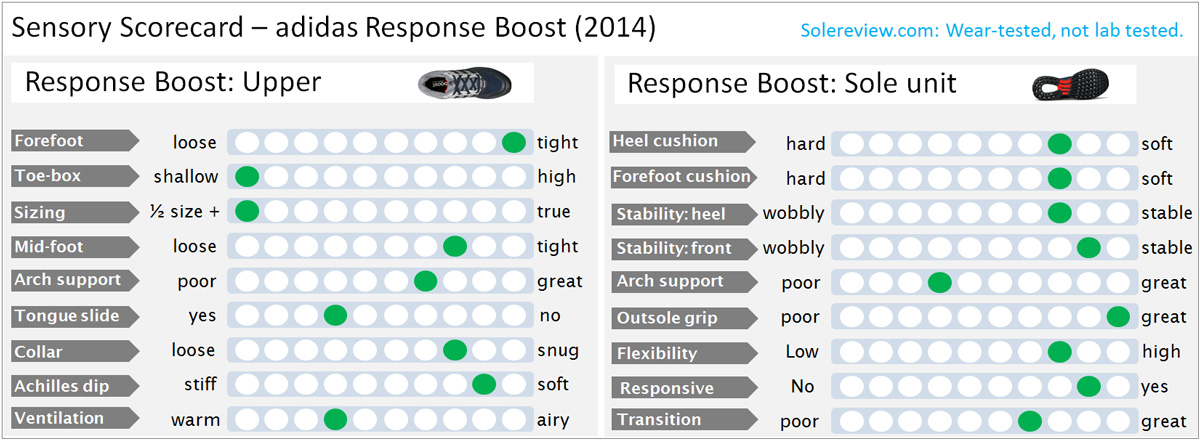

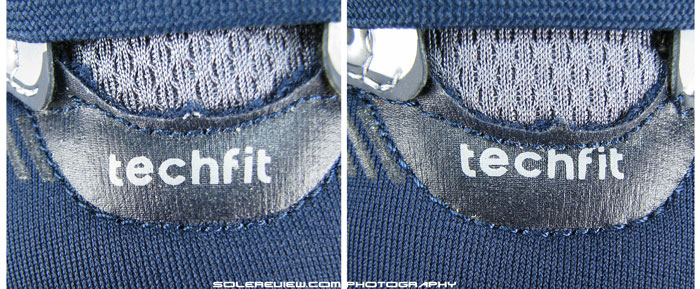









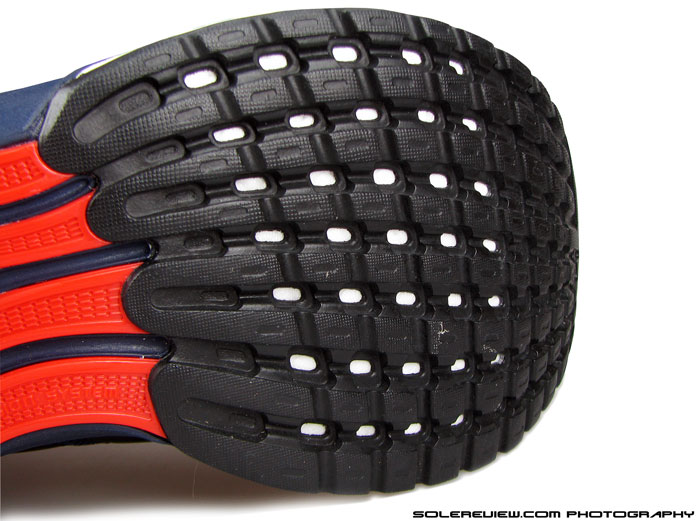
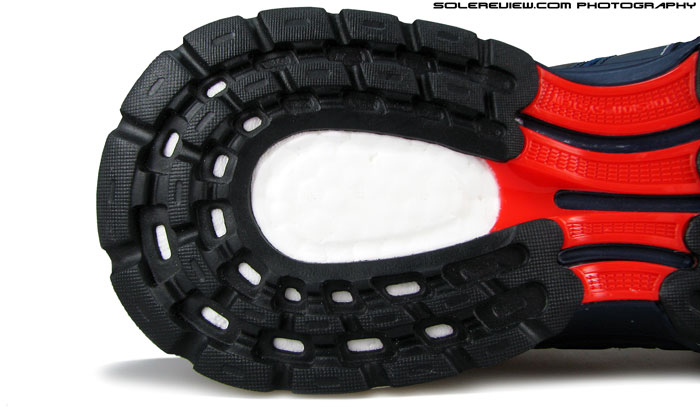
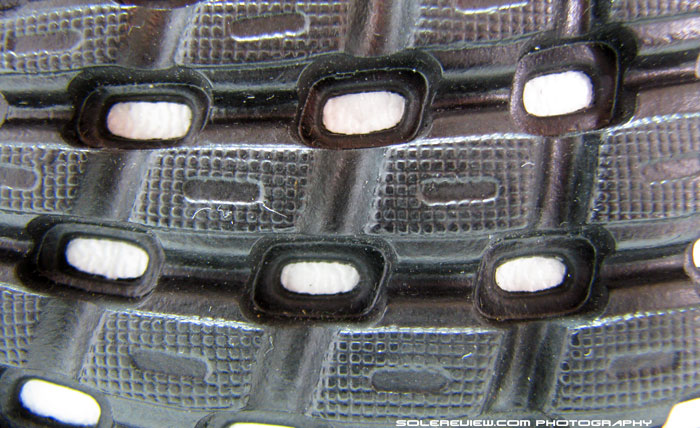
64 comments
There’s nothing out there with so much depth of your reviews, once again, congrats. Some of the shoes that you review don’t look very promising, like this one, but is always a pleasure to read from start to finish, here and there surprises may appear.
The Response’s upper looks like it was made on the rush (and in early 2000’s), what brings the memory of the Energy Boost review, in which you say Adidas to “scale up” before “anyone else gets wiser” and the Nike Free 4.0, with your graph of estimated costs.
Is Adidas following the tip and doing things faster to savour the momentum of the Boost in sales? Designing some shoes with a price tag in mind, throwing boost and playing Candy Crush?
Thank you! At times we are taken by surprise too, with some shoes throwing up a bunch of findings once they hit the road. In most cases, the first impression isn’t the last, as each run reveals newer things about the shoe being tested.
adidas is just capitalising on the new found popularity of Boost and trying to make most of the momentum. The problem with Boost is that it makes other EVA based models feel ordinary in comparison, so it is logical that they gradually upgrade more shoes on to the new platform.
But as evident from the Response Boost, their tiering strategy is vague in execution. What’s confusing is that there are some models available internationally and not in the US. The similarly priced Revenergy Boost has a far more premium upper than the Response version. But the midsole runs firm on that one, like the Sonic Boost.
Are you using the name “Revenergy” and “Energy” synonymously? Because in my market area (Detroit, MI), there is a $70 price difference between the Energy and the Response Boost shoes (Energy is $70 more). While I don’t much care about aesthetics for that price differential, I do care about mileage capability (I usually get 700+ miles on my Energy shoes) and toe box width.
Not at all. We’re aware that the Revenergy is a different model with a firmer ride!
Is this the other Response Boost?
http://www.adidas.com/us/product/mens-running-response-23-shoes/ILL78?cid=M18776&breadcrumb=1z13071Z1z11zrfZsvZu2Z1z1371yZ1z13y9l
Indeed. Thanks for sharing.
Not sure what adidas is trying to do here. If possible, we’ll try to buy this pair for a review as well.
Oh, this is actually the original Response Boost, the pair you reviewed was the Response Boost Techfit, which was actually released a bit later than the original Response Boost. Both shoes are still available and cost the same though. BTW, great review as always! :)
Response Boost Techfit:
http://www.adidas.com/us/product/mens-running-response-23-techfit-shoes/ILM01?cid=M18620&breadcrumb=1z13071Z1z11zrf&search=Response+Boost+Techfit+Shoes+in+Men%27s+Running&cm_vc=SEARCH
Thanks. The widespread PR release for Response Boost shows only the techfit version, and all the major retailers seem to stock only this model in the US.
It is nevertheless confusing, because neither of the Response Boost models have a ‘techfit’ or ‘ESM’ suffix to their description, which is the case for Energy Boost.
Yeah, with all these different boost models and variations out there, it’s pretty hard to tell which is which.
During my vacation to China, I actually tried on the Revenergy Boost. :d The upper was nice, not too constricting, but not too loose, a bit stretchy and spandexy, similar to the rest of the Techfit shoes Adidas has out there (at least for me). The midsole, however, felt nothing like a boost shoe. It was slightly softer and more responsive than a regular EVA midsole, but not even close to “regular” boost levels. This is probably due to the fact that it doesn’t have any exposed boost, as the only visible boost was on the bottom of the shoe. It seems to use boost in a similar manner to Nike Air, as in inside the shoe vs other Boost shoes, which utilize Boost in a manner much more similar to Max Air, which is visible. The Boost is encased in standard, relatively firm EVA and doesn’t seem to compress much due to this. I took out the standard molded EVA insole to take a look at the strobel, and it’s pretty much a fabric one similar to the ones used on lower end Nike shoes (Revolution, Relentless, etc.). It was firm, and dampened the cushioning, decreasing the plushness of the ride. This is actually different from the rest of the Boost shoes I’ve tried, as they all had holes in the strobel and had minimal effect on the cushioning, being either filmic or a much thinner and pliable form of fabric as on the Response Boost.
It costs the same as the Response Boost (899 RMB or about $150, brand name shoes cost more in China) and brings up the question why anyone would rather buy the Revenergy Boost vs the Response boost when they both cost the same amount.
Appreciate the detailed insight. From what you describe, it seems that the Revenergy Boost is similar to the Sonic, with encapsulated Boost resulting in a much firmer ride.
You’re right about the pricing, adidas is all over the place with this. Given a choice between the Response and the Rev, the one with more Boost is the obvious winner.
Oh. Thank you very much. I am quite interested in the Revenergy (the price is attractive, to be honest), and that sounds perfect for me. The Response Boost is too soft for me. The Supernova Glide is pretty good, but it could be a bit stiffer. Regular EVA midsole shoes are a bit hard though, I’d like it a bit softer. Something in between sounds good.
can replacing the insole with a thinner (adiZero insoles come to mind) one fix the forefoot problem? (although the fit might take a huge hit…)
I would just recommend buying the non-techfit version of the Response Boosts. The forefoot is a lot roomier and it’s also much more breathable due to the upper being constructed from mesh.
http://www.adidas.com/us/product/mens-running-response-23-shoes/ILL78?cid=M18776&breadcrumb=1z13071Z1z11zrf&search=response&cm_vc=SEARCH
Sorry for the delay in reply. Replacing the sockliner with that of Adios Boost opens up some room on the sides, but it is still very crunched over the toe.
so mesh it is then… sucks… i always loved how techfit hugs the skin (see crazyquick runners) i only tried it in the store but i like the level of cushioning the SGB has over these… not so much and not so little, just right in the middle.
you are offering great insights how adidas is not pushing boost into its full potential… like how the response boost are priced the same with the sonic boost 2 (forefoot only boost) here in the philippines..
Does adidas have the Sonic Boost out in Phillipines? Had no idea at all, do you have a link to an online store where we can see them?
testing..
Never seen these before, thanks for sharing!
Having put about 70 miles on my Response Boosts, I have the following observations:
– I had concerns (as the author expressed) about the durability of the black rubber sole surface due to the relative softness, but so far so good. I am a heelstriker and it normally shows, but I wouldn’t say that the heel wear hasn’t been premature compared to my other shoes. I’m around 130 pounds though, so that probably helps.
– Techfit has worked well for me, since I have a narrow foot, but I certainly concur that this shoe is not for someone who needs toe room.
– Upper durability has good so far, as I only wear them for running (street surface) and not at other times as casual wear. A few runs in the rain illustrated that they dry quickly.
– Although lacking the more rigid plastic heel cage of the Energy Boost, I have been pleased with how well these grip the heel and provide rear stability.
– I agree with the author and really wish there was an additional eyelet row for lacing. Not a huge discomfort by any means, but would just provide a better feel.
– Although they have a lesser amount of Boost material in the sole compared to the Energy Boost, they still provide a nice ride, my knees, hips, calves, etc. feel great even after double-digit mile runs.
Hope these comments help those who are on the search for the right shoe! :-)
Thank you for sharing very detailed insights from your medium term ownership of the Response Boost. Like you said, it helps others and also us!
Tried a pair of these on yesterday. Unbelievably tight over the toes and going a half size up simply gave me a shoe that was too long.
I thought the drop felt less steep than the Energy Boost 2 which I liked. Does the Glide feel similar?
I also thought some of the felt cushioning could probably be attributed to the gummy sole. There isn’t nearly as much rubber on the other Boost models I’ve seen.
No, the Glide feels much more sorted in upper and midsole (heel drop and cushioning) feel. Yes, agree that soft rubber contributes to the cushioned feel.
@Solereview – you might wanna test the mesh upper boost… although i just tried them in store, but the mesh has a way way way different feel than the techfit… plus the insoles are different… its really a different shoe. just my 2 cents
Thanks for the suggestion and insights, will try to squeeze it sometime soon!
Thanks for the great, thorough review! I’m glad I found your webpage after ending up totally confused by Adidas official running shoe page…
You’re welcome. Truth be told, we also find the adidas website very difficult to navigate.
Hi, I am really new to this shoes tech. I have looking out for a pair of shoes since couple weeks now and have tried out a few of them. But going thru the Internet, have realised that there lots of stuff to know about shoes.
This review is really good. Havent found a similar one yet about shoes.
Please advise me. I am looking for trainers which looks good as well as has lots of cushioning. I dont run or anything. This is just for casual day to day use.
I used, adidas rsp cushion, for a day. Found the cushion effect really good. But even size 10 seemed to be tight in the forefoot region. Really liked the cushion softness while walking but not the fit that much. The nike air max 2014 surprisingly dint feel that much cushioned, maybe coz I just tried it on for like 10mts.
Also, these mesh front shoes, is it wearable in winter, coz I could feel the wind through the mesh in the adidas rsp cushion.
Are thr shoes with the normal material other than the mesh thing so that the feet doesnt get cold in winter. But with similar level of cushion as adidas rsp cushion???
Thank you.
Most adidas shoes are narrow in the forefoot, but the Supernova Glide 6 (or 7) Boost is has more room – that shoe is something you could try.
If you need more warmth, then try the Nike Pegasus 31 (Flash version) which is meant for colder weather. However, the cushioning doesn’t feel as good as the Response Boost.
Thank you.
1. So in terms of cushioning feel, adidas is better than nike ones?
2.What’s the difference in response boost, techfit and mesh ones? Thr are these two types in response boost rite? The techfit one doesn’t allow that much cold in, like the mesh ones?
3. As per your review, response boost has more cushion than revenergy boost? But response boost cushion Rated only 9.3 against for revenergy boost 9.7.
1.) That is subjective, depending on the model. Some adidas shoes might be better than Nike, and vice versa. Hard to generalize.
2.) The Response Boost reviewed here is the Tech Fit version. The techfit is a stretch mesh, and will be slightly less ventilated than the open mesh version.
3.) We do not say that in our review. The Energy Boost and Revenergy Boost are two different models. The Energy Boost is more cushioned than Response, and Revenergy is less cushioned than response.
Thank you.
1.There was a graph shown in the beginning of the review. With different aspects of the shoes rated. The revenergy cushion rating was shown as higher than the response boost one. That’s why I thought that the graph was part of your review as well.
2. I had a try of the Nike flex 2014 version. Which was so lightweight and relaxing sort of. But dont know abt its cushioning. Is thr a shoes in ur opinion with flexibility as that, along with the cushioning of adidas rsp cushion?
1.) You are confusing Revenergy Boost with Energy Boost :) . We have reviewed the Energy Boost, but NOT the Revenergy Boost. These are the names of two completely different models! The graph is part of our review, that is correct.
The Energy Boost cushioning at 9.7 is higher than Response Boost (9.3), you have observed correctly – and that happens to be true.
2.) Try the Supernova Glide Boost 6.
Yes, that was an assumption I made. Since you mentioned in the review that revenergy boost are the latest version of sonic boost shoes. The rating of sonic boost cushion and overall rating seemed to be higher than the response boost shoes, in the graph.
But in the written part of review, it said that the sonic boost had lesser cushioning than response boost. So I got confused when the graph showed different rating. The sonic boost 9.7 cushion to 9.3 of response boost.
Btw, the revenergy boost are different from sonic boost? I assumed that since its an upgrade of sonic boost, essentially it’s the same. I was planning to go for the revenergy one, since that seems to be the cheapest now.
Thank you and sorry for all the stupid q
Actually our cushioning scores work in a slightly complex way, combining six different attributes instead of judging it on just how soft it is.
In simple words, we rate cushioning on the quality of it – like stability, responsiveness, compression, etc. However, this was difficult for a lot of people to understand. That is why our recent reviews do not show separate scores for cushioning, stability etc.
In theory, yes, the Revenergy appears to be the Sonic’s successor, but we can’t offer a weartested opinion because we haven’t reviewed it, and no plans to do so.
No worries about the questions, ask as many as you want!
Thank you.
1.The adistar boost and Energy boost 2. How do they fare against each other. From wat I gathered so far, adistar boost sits Lil higher in the line than Energy boost with more relaxed fit?
2.So the supernova glide boost 6 is something which is similar to the Nike flex run 2013, in flexibility and more cushioning? Wats the difference among the supernova glide boost and the supernova sequence boost series
1). We haven’t reviewed the Adistar Boost, so can’t offer an opinion on that one.
2). The SGB-6 is less flexible compared to Flex Run, although Boost has more cushioning. But two different shoes, really.
Our Sequence 7 Boost covers your question in detail:
https://www.solereview.com/adidas-supernova-sequence-7-boost-review/
In some places I have read that the Revenergy is for overpronaters, but other sources don’t mention it or say it is normal. And some reviews read like they are mixing them up with Energy Boost, or Response Boost, or any other model. It’s quite confusing because it’s one of the less common Boost models… The Adidas website doesn’t mention pronation…
One thing I didn’t like with the Response Boost is the way you sink in while standing. It’s just too much, it feels like you are dropping in a hole, and you can actually feel the circular cut out with your heel. It’s irritating, and over a longer duration might even be unpleasant. That’s the genius with the Supernova Glide, the added EVA layer completely avoids that issue.
I really wonder how the Revenergy is, cause it is good looking _and_ affordable.
Won’t be able to make any assessment of the Revenergy without trying them – which we have no plan for.
Hi and thank you for your great reviews.
Do you have any information on how the non-Techfit model fits?
Thank you!
Hi there! Sorry, never got around to the non-TF version for review. However, we remember a comment somewhere down below from a reader who had worn it. He had some feedback, so you might want to ask him.
Thank you!
I found a pair of the non-techfit version at an adidas outlet store today for $80. I also had a 15% off coupon, so if all I find wrong with them is lack of durability, I’ll be happy give what I ultimately paid! Other than that, the only drawback is that they’re mustard yellow. Don’t know what adidas was thinking there. :-( The mesh does seem quite airy and breathable. It will be plenty hot here in Texas soon enough, so that’s a big plus.
I almost pulled the trigger on a pair of Pegasus 31s, but one I tried the Response Boost on, I chose them. They’re roomy enough that I didn’t have to go up in size.
Am I to assume that all info in the above review pertaining to the ride and feel underfoot is the same? Thanks.
$80 is a good deal on the shoe! Yes, underfoot ride experience will be identical.
They also had the Techfit version in a couple of different colorways, but this one seemed obviously preferable. Didn’t even try on any of the others.
Go for it, we’d say.
A couple of photos of the non-TechFit version in puke yellow. The closest thing I’ve ever worn in comparison to this shoe, fit-wise would be the Nike Free. Much softer and responsive, however. I currently have an issue with Morton’s neuroma in my right foot, and it felt much better running in this shoe. I’d call that a huge plus. (My daily trainer before this was the Nike Zoom Elite 6)
I noticed a quality control issue with a fabric wrinkle in the toe area that’s noticeable in photo #1, a medial side shot. Can’t feel it, though. There’s also a funny design thing with an overly padded collar (photo #3) that makes it protrude farther out than it looks like it needs to. Whatever. Doesn’t cause a problem just looks goofy.
Thank you for sharing the pictures. Good to know the shoes seem to be working for you.
That wrinkle is just a mis-lasted toe puff, and should not affect performance. As far as the collar is concerned – that typical adidas design quirk. You should look at the Utlra Boost collar!
Bought a pair and have a little more than 20 miles on them. I’m developing pain on my shins, knees and hips, specially in the groin area. Any suggestion will be a welcome. I come from Asics and Brooks. Medium arc and neutral.
What kind of specific physical conditioning/strengthening exercises do you include along with your running?
Bought those for $40 (clearance) at local Academy store. I didn’t really need a pair but after reading your review and at that price… :)
I have to tell you that those shoes are sooo comfortable that not only I train hard with them, but I pretty much wear them everyday as well.
I’ve put about 40 Ks on mine so far — 70% pavement / 30% trail:
– They look as good today as when I first bought them. no wear issue (see pic).
– They run hot. First time wearing them I actually developed blisters in toes, which didn’t happen since my last half-Marathon. So that was a surprise. But for cold winter runs? Greeeat! (cleaning the white boost sole is a bit of a pain, it gets dirty fast down there though)
– I’m a forefoot striker and the first run felt funky under my right forefoot. It was like there was a protuberance of Boost or a hard bubble in one specific area that came out of nowhere but after 30 min the “bubble” was gone. I guess the Boost bubble had to find its place?
– I have a narrow and long foot and they fit great, although a bit wider than the Faas 300 which is a perfect fit for me. I wear a strong arch support insole so I ditched the insole.
– Agreed on the missing eyelet for lacing. Not a deal breaker but it feels like it’s missing. especially if you have narrow foot and trying to really tie it tight.
—> and they look great for everyday wear with jeans, since they have a bit of a soccer/streetwear style in black/white.
Thank you for the detailed feedback and the pictures!
I must add that i purchased the same shoes for my 10 yr old who wears them at school, and her outsole lip is already starting to “peel off”. So i’m gonna have to look into superglueing that back up :( Let me know if you have any recommendation for that.
Superglue is a hard compound, and tends to crack under use. If you’ve already applied it, remove it with an Acetone based nail polish remover (Revlon sells one).
Then proceed to apply Gorilla glue (buy the smallest tube/bottle). That is a polyurethane based adhesive, similar to industrial cement used on shoes.
perfect. I will do just that. Thanks for the tip
You’re welcome. Acetone nail polish remover should work as long as the superglue used was Cyanoacrylate based – which most of the commonly sold tubes are. Dab liberally with a small piece of cloth, let the chemical reaction happen between the glue and Acetone for a few minutes. Then scrap off the softened superglue.
Bought the previous model but seldom wear, mostly once a week.
After 1.5 years the glue on soles are giving way on both sides at about the same time. It seems Adidas running shoes’ glue are so bad, non-lasting. Some of the parts at the sole bottom are unable to last even after glue back.
Thank you for the feedback. Though we have not faced such an issue, some of the recent adidas shoes we’ve reviewed aren’t up to mark on fit and finish.
my 9yr old daughter has the response boost as well, and the front sole tips have become completely unglued in front as stated previously. but she is rough on them. the gorilla glue didn’t work so well i’m afraid to say. BUT… she loves them so much that she made me get a new pair on ebay despite the unglue issue.
QUESTION: the response boost 2.0 just came out. as anyone tried them? are they better than 1.0?
Haven’t given the Response 2.0 a try, but let’s see if we have create a review slot sometime soon.
The problem with trying to fix running shoe outsoles on our own is that the priming+curing+pressure part of the process isn’t feasible outside of an industrial set-up. Hence the limitations with even a strong adhesive like Gorilla Glue. The Shoe goo is another option, after sanding the midsole and outsole and scraping off the earlier glue.
i just purchased the 2.0 and will receive them this week. it looks like they have fixed the number of lacing holes at least. thank you for the extra tips on glueing the lips.
Great to hear that, hopefully we should have a review out soon.
I got these on sale and they are slightly different to the ones you have pictured. I guess the Australian market ones are different. I will say this shoe is very, very comfortable. I can’t believe it. I ran about 30km off road in them, then went to get another pair as spare.
No issues here yet and I am a heavy thrasher.
Thanks for the reviews that you do.
Thank you for the feedback! There are currently two versions of the Response Boost around, so guessing you picked up the ESM one, which is completely different from what’s reviewed here.
Comments are closed.